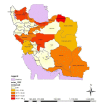Indoor environment assessment of special wards of educational hospitals for the detection of fungal contamination sources: A multi-center study (2019-2021)
- PMID: 37736609
- PMCID: PMC10509496
- DOI: 10.32598/CMM.2023.1370
Indoor environment assessment of special wards of educational hospitals for the detection of fungal contamination sources: A multi-center study (2019-2021)
Abstract
Background and purpose: The hospital environment was reported as a real habitat for different microorganisms, especially mold fungi. On the other hand, these opportunistic fungi were considered hospital-acquired mold infections in patients with weak immune status. Therefore, this multi-center study aimed to evaluate 23 hospitals in 18 provinces of Iran for fungal contamination sources.
Materials and methods: In total, 43 opened Petri plates and 213 surface samples were collected throughout different wards of 23 hospitals. All collected samples were inoculated into Sabouraud Dextrose Agar containing Chloramphenicol (SC), and the plates were then incubated at 27-30ºC for 7-14 days.
Results: A total of 210 fungal colonies from equipment (162, 77.1%) and air (48, 22.9%) were identified. The most predominant isolated genus was Aspergillus (47.5%), followed by Rhizopus (14.2%), Mucor (11.7%), and Cladosporium (9.2%). Aspergillus (39.5%), Cladosporium (16.6%), as well as Penicillium and Sterile hyphae (10.4% each), were the most isolates from the air samples. Moreover, intensive care units (38.5%) and operating rooms (21.9%) had the highest number of isolated fungal colonies. Out of 256 collected samples from equipment and air, 163 (63.7%) were positive for fungal growth. The rate of fungal contamination in instrument and air samples was 128/213 (60.1%) and 35/43 (81.2%), respectively. Among the isolated species of Aspergillus, A. flavus complex (38/96, 39.6%), A. niger complex (31/96, 32.3%), and A. fumigatus complex (15/96, 15.6%) were the commonest species.
Conclusion: According to our findings, in addition to air, equipment and instrument should be considered among the significant sources of fungal contamination in the indoor environment of hospitals.
Keywords: Airborne fungi; Equipment; Hospital; Indoor air; Sources of fungal contamination.
Copyright: © 2021, Published by Mazandaran University of Medical Sciences on behalf of Iranian Society of Medical Mycology and Invasive Fungi Research Center.
Conflict of interest statement
The author(s) declared no potential conflicts of interest with respect to the research, authorship, and/or publication of this article.
Figures



References
-
- Khan HA, Baig FK, Mehboob R. Nosocomial infections: Epidemiology, prevention, control and surveillance. Asian Pac J Trop Biomed. 2017; 7(5):478–482.
-
- Prigitano A, Perrone PM, Esposto MC, Carnevali D, De Nard F, Grimoldi L, et al. ICU environmental surfaces are a reservoir of fungi: species distribution in northern Italy. J Hosp Infect. 2022; 123:74–9. - PubMed
LinkOut - more resources
Full Text Sources
